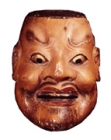Japanese Gallery (Honkan) Room T1
February 5, 2008 (Tue) - March 2, 2008 (Sun)
Noh is a traditional form of theatre where actors wear masks. Its origins lie in Sarugaku, a form of theatre popular between the 11th and 14th centuries. Since it was performed during Shinto or Buddhist festivals, so many Noh masks are owned by shrines and temples.
During the Nanbokucho period (1333-1392), Sarugaku performances held at Kasuga Shrine and Kofukuji Temple were performed by four troupes: Yusakiza (Kanzeza), Tobiza (Hoshoza), Sakatoza (Kongoza), and Enmanza (Konparuza).The Sakatoza troupe eventually was divided to become the Kita troupe.
The father-son duo of actor-playwrights Kan'ami and Zeami were from the Yusakiza troupe and were patronized by the shogun Ashikaga Yoshimasa. Successive shoguns also appreciated Noh, which Zeami had perfected into a performing art, and it eventually became the official ceremonial theater art of the warrior class. Feudal lords collected many masks from the performances they sponsored.
The period from the Nanbokucho through the Muromachi period (1392-1573) could be called a "period of originality" where new plays were created in succession and the variety of expressive masks increased accordingly. Masks produced at this time are now treasured as hon-men (main masks). The following Azuchi-Momoyama (1568-1603) and Edo (1603-1867) periods could be considered a "period of imitation" of inherited styles - in the case of Noh masks, the shapes, carvings, scratches, and even flakes by master mask makers such as Deme Zekan Yoshimitsu and Kawachi Daijo Ieshige were faithfully reproduced. It is difficult to date Noh masks due to the close correlation and rare opportunities to see hon-men masks.
The Tokyo National Museum has more than 200 Noh masks. In 1950 the museum purchased 47 masks and costumes that were preserved by the Konparuza troupe. This display includes works dating from the Muromachi through the Edo period - from the "period of originality" to the "period of imitation."

